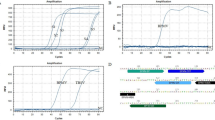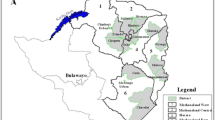Abstract
A virus survey of field pea (Pisum sativum) and faba bean (Vicia faba) crops in southern NSW and Victoria in October, 2006, provided the opportunity to compare the diagnostic results of a large number of field samples using reverse transcription polymerase chain reaction (RT-PCR) to the accepted reference test of tissue blot immunoassay (TBIA). One hundred unbiased plant samples from each of 21 field pea and three faba bean crops from NSW and ten field pea crops from Victoria were tested for Alfalfa mosaic virus (AMV), Bean yellow mosaic virus (BYMV), Cucumber mosaic virus (CMV), Pea seed-borne mosaic virus (PSbMV), Bean leafroll virus (BLRV) and Beet western yellows virus (BWYV) by TBIA. PSbMV was present at high levels (32–77 %) in 12 out of 21 field pea crops sampled from NSW. BLRV was present at high levels (28–42 %) in faba bean crops from NSW. In Victorian field pea crops, BWYV was most prevalent (4–28 %). Other viruses tested for were present at low incidences or absent. The seed to seedling transmission rate of PSbMV in the field pea seedlots used to sow six of the surveyed NSW pea crops, determined by TBIA, ranged from 0 to 23 % and had a clear effect on the level of PSbMV in the field. Test results for PSbMV and BLRV using TBIA were compared with results using RT-PCR and compared favourably in giving similar estimates of infection incidence and low costs (both less than A$1.00 per sample) for detecting these two viruses. It is concluded that TBIA is the preferred technique to get a precise estimate of infection incidence, while RT-PCR is particularly useful to test bulk samples for the presence of viruses with a low incidence and provides an alternative if antiserum is not available.
Similar content being viewed by others
References
Abraham A, Makkouk KM (2002) The incidence and distribution of seed-transmitted viruses in pea and lentil seed lots in Ethiopia. Seed Sci Technol 30:567–574
Abraham A, Makkouk KM, Gorfu D, Lencho AG, Ali K, Tadesse N, Yusuf A, Lencho A (2000) Survey of faba bean (Vicia faba L.) virus diseases in Ethiopia. Phytopathol Mediterr 39:277–282
Aftab M, Freeman A, Davidson J (2005) Pulse virus surveys in south eastern Australia (2003–2004). In: Proceedings of the Australasian Plant Pathology Society 15th Biennial Conference, 24–29 Sept 2005, Geelong, Victoria, p. 338
Aftab M, Freeman A, Davidson J (2009) Pulse virus surveys from Victoria and South Australia in 2007. In: Proceedings of the Australasian Plant Pathology Society 17th Biennial Conference: 29 Sept–1 Oct 2009, Newcastle, NSW, p. 131
Bao S, Wang X, Zhu Z, Zong X, Kumari S, Freeman A, van Leur J (2007) Survey of faba bean and field pea viruses in Yunnan Province, China. Australas Plant Pathol 36(4):1–7
Constable FE, Connellan J, Nicholas P, Rodoni BC (2012) Comparison of enzyme-linked immunosorbent assays and reverse transcription-polymerase chain reaction for the reliable detection of Australian grapevine viruses in two climates during three growing seasons. Aust J Grape Wine Res 18:239–244
Coutts BA, Prince RT, Jones RAC (2009) Quantifying effects of seedborne inoculum on virus spread, yield losses, and seed infection in the Pea seed-borne mosaic virus - field pea pathosystem. Phytopathology 99:1156–1167
Fletcher JD (1993) Survey of virus diseases in pea, lentil, dwarf and broad bean crops in South Island New Zealand. N Z J Crop Hortic Sci 21:45–53
Freeman AJ, Aftab M (2001) Surveying for and mapping of viruses in pulse crops in south-eastern Australia. In: Proceedings of the Australasian Plant Pathology Society 13th Biennial Conference, 24–27 Sept 2001, Cairns, Queensland, p. 149
Freeman AJ, Aftab M, Dobson V (2003a) Surveying for viruses in pulse crops in Victoria. In: Proceedings of the 8th International Congress of Plant Pathology, 2–7 Feb 2003. Christchurch, New Zealand, p. 261
Freeman A, Aftab M, Dobson V (2003b) The incidence of seedborne viruses in lentil crops in Victoria and South Australia. In: Proceedings of the 8th International Congress of Plant Pathology, Christchurch, New Zealand, 2–7 Feb. 2003, p. 261
Freeman A, Aftab M, McQueen V, Davidson J (2005) The occurrence of common viruses in pulse crops in south eastern Australia. In: Proceedings of the 15th Biennial Australasian Plant Pathology Society Conference, Geelong, Sept, 2005, p. 339
Hepworth G (2005) Confidence intervals for proportions estimated by group testing with groups of unequal size. J Agric Biol Environ Stat 10:478–497
Hill MF, Giles RJ, Moran JR, Hepworth G (1996) The incidence of chrysanthemum stunt viroid, chrysanthemum B caravirus, tomato aspermy cucumovirus and tomato spotted wilt tospovirus in Australian chrysanthemum crops. Australas Plant Pathol 25:174–178
Hsu HT, Lawson RH (1991) Direct tissue blotting for detection of tomato spotted wilt virus in Impatiens. Plant Dis 75:292–295
Latham LJ, Jones RAC (2001) Incidence of virus infection in experimental plots, commercial crops, and seed stocks of cool season crop legumes. Aust J Agric Res 52:397–413
MacKenzie DJ, McLean MA, Mukerji S, Green M (1997) Improved RNA extraction from woody plants for the detection of viral pathogens by reverse transcription-polymerase chain reaction. Plant Dis 81:222–226
Makkouk K, Comeau A (1994) Evaluation of various methods for the detection of barley yellow dwarf luteovirus by the tissue-blot immunoassay and its use for BYDV detection in cereals inoculated at different growth stages. Eur J Plant Pathol 100:71–80
Makkouk K, Kumari S (1996) Detection of ten viruses by the tissue-blot immunoassay (TBIA). Arab J Plant Prot 14:3–9
Makkouk KM, Kumari SG, Shahraeen N, Fazlali Y, Farzadfar S, Ghotbi T, Mansouri AR (2003) Identification and seasonal variation of viral diseases of chickpea and lentil in Iran. Z Pflanzenkrankh Pflanzenschutz 110:157–169
Moran JR, Wilson JM, Garrett RG, Smith PR (1985) ELISA indexing of commercial carnations for carnation mottle virus using a urease-antibody conjugate. Plant Pathol 34:467–471
Najar A, Makkouk KM, Boudhir H, Kumari SG, Zarouk R, Bessai R, Othman FB (2000) Viral diseases of cultivated legume and cereal crops in Tunisia. Phytopathol Mediterr 39:423–432
Ortiz V, Castro S, Romero J (2005) Optimization of RT-PCR for the detection of Bean leaf roll virus in plant hosts and insect vectors. J Phytopathol 153:68–72
Rodoni BC, Hepworth G, Richardson C, Moran JR (1994) The use of a sequential batch testing procedure and ELISA to determine the incidence of five viruses in Victorian cut-flower Sim carnations. Aust J Agric Res 45:223–230
Schwinghamer MW, Thomas JE, Parry JN, Schilg MA, Dann EK (2007) First record of natural infection of chickpea by Turnip mosaic virus. Australas Plant Dis Notes 2:41–43
Shepherd M, Cross MJ, Stokoe RL, Scott LJ, Jones ME (2002) High-throughput DNA extraction from forest trees. Plant Mol Biol Report 20:425a–425j
Tadesse N, Ali K, Gorfu D, Yusuf A, Abraham A, Ayalew M, Lencho A, Makkouk KM, Kumari SG (1999) Survey for chickpea and lentil virus diseases in Ethiopia. Phytopathol Mediterr 38:149–158
Thomas JE, Schwinghamer MW, Pary JN, Sharman M, Shilg MA, Dann EK (2004) First report of tomato spotted wilt virus in chickpea (Cicer arietinum) in Australia. Australas Plant Pathol 33:597–599
Thomas JE, Parry JN, Schwinghamer MW, Dann EK (2010) Two novel mastreviruses from chickpea (Cicer arietinum). Aust Arch Virol 155:1777–1788
van Leur JAG, Makkouk KM, Freeman AJ, Schilg MA (2003) Occurrence of viruses in faba bean on the Liverpool Plains, northern New South Wales. In: Proceedings of the 8th International Congress of Plant Pathology, 2–7 Feb 2003, Christchurch, New Zealand, p. 265
van Leur JAG, Aftab M, Manning W, Bowring A, Riley MJ (2013a) A severe outbreak of chickpea viruses in northern New South Wales, Australia, during 2012. Australasian Plant Disease Notes. doi:10.1007/s13314-013-0093-y
van Leur JAG, Kumari S, Aftab M, Leonforte A, Moore S (2013b) Virus resistance of Australian pea (Pisum sativum) varieties. N Z J Crop Hortic Sci 41(2):86–101. doi:10.1080/01140671.2013.781039
Acknowledgments
We would like to acknowledge the technical assistance of Janine Sipple, Finn Fensbo and Merv Riley. We also thank the NSW DPI District Agronomists for providing pea seed lots. This study was financially supported by the Grains Research and Development Corporation, Australia.
Author information
Authors and Affiliations
Corresponding author
Rights and permissions
About this article
Cite this article
Freeman, A.J., Spackman, M.E., Aftab, M. et al. Comparison of tissue blot immunoassay and reverse transcription polymerase chain reaction assay for virus-testing pulse crops from a South-Eastern Australia survey. Australasian Plant Pathol. 42, 675–683 (2013). https://doi.org/10.1007/s13313-013-0252-9
Received:
Accepted:
Published:
Issue Date:
DOI: https://doi.org/10.1007/s13313-013-0252-9




